Hyundai SANTAFE 2011, SANTAFE 2010 Owner Manual
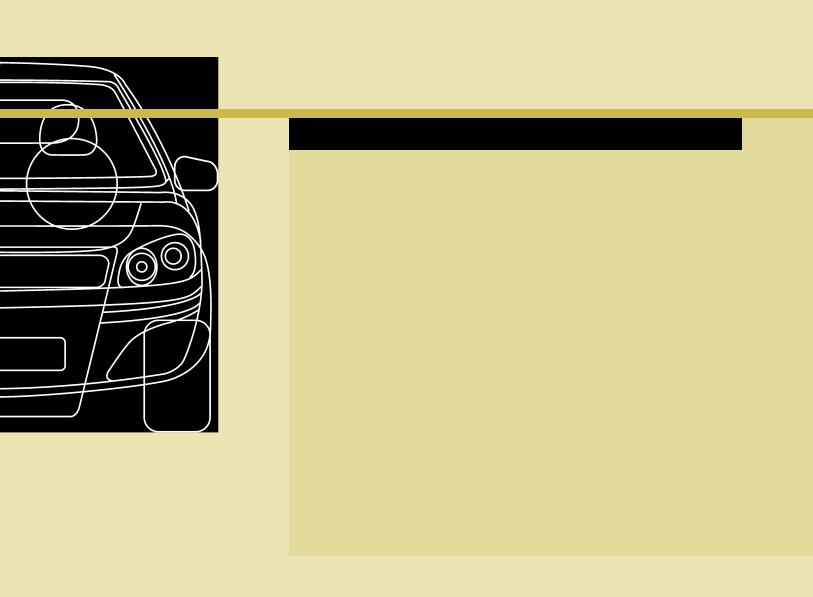
OWNER'S MANUAL
Santa Fe
Operation
Maintenance
Specifications
All information in this Owner's Manual is current at the time of publication. However, Hyundai reserves the right to make changes at any time so that our policy of continual product improvement may be carried out.
This manual applies to all Hyundai models and includes descriptions and explanations of optional as well as standard equipment. As a result, you may find material in this manual that does not apply to your specific vehicle.

CAUTION: MODIFICATIONS TO YOUR HYUNDAI
Your Hyundai should not be modified in any way. Such modifications may adversely affect the performance, safety or durability of your Hyundai and may, in addition, violate conditions of the limited warranties covering the vehicle. Certain modifications may also be in violation of regulations established by the U.S. Department of Transportation and other federal or state agencies.
TWO-WAY RADIO OR CELLULAR TELEPHONE INSTALLATION
Your vehicle is equipped with electronic fuel injection and other electronic components. It is possible for an improperly installed/adjusted two-way radio or cellular telephone to adversely affect electronic systems. For this reason, we recommend that you carefully follow the radio manufacturer's instructions or consult your Hyundai dealer for precautionary measures or special instructions if you choose to install one of these devices.
F2
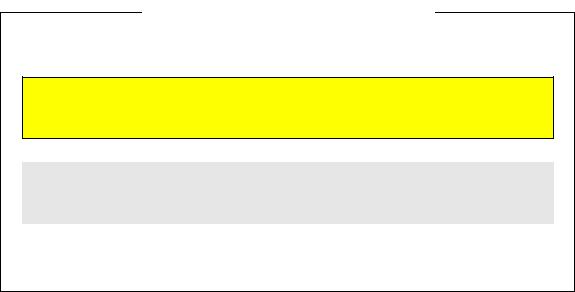
SAFETY AND VEHICLE DAMAGE WARNING
This manual includes information titled as WARNING, CAUTION and NOTICE.
These titles indicate the following:
 WARNING
WARNING
This indicates that a condition may result in harm, serious injury or death to you or other persons if the warning is not heeded. Follow the advice provided with the warning.
 CAUTION
CAUTION
This indicates that a condition may result in damage to your vehicle or its equipment if the caution is not heeded. Follow the advice provided with the caution.
NOTICE
This indicates that interesting or helpful information is being provided.
F3

FOREWORD
Thank you for choosing Hyundai. We are pleased to welcome you to the growing number of discriminating people who drive Hyundais. The advanced engineering and high-quality construction of each Hyundai we build is something of which we're very proud.
Your Owner's Manual will introduce you to the features and operation of your new Hyundai. It is suggested that you read it carefully because the information it contains can contribute greatly to the satisfaction you receive from your new car.
The manufacturer also recommends that all service and maintenance on your car be performed by an authorized Hyundai dealer. Hyundai dealers are prepared to provide high-quality service, maintenance and any other assistance that may be required.
HYUNDAI MOTOR AMERICA
Note : Because future owners will also need the information included in this manual, if you sell this Hyundai, please leave the manual in the vehicle for their use. Thank you.
 CAUTION
CAUTION
Severe engine and transaxle damage may result from the use of poor quality fuels and lubricants that do not meet Hyundai specifications.You must always use high quality fuels and lubricants that meet the specifications listed on Page 8-4 in the Vehicle Specifications section of the Owner's Manual.
Copyright 2009 Hyundai Motor America. All rights reserved. No part of this publication may be reproduced, stored in any retrieval system or transmitted in any form or by any means without the prior written permission of Hyundai Motor America.
F4
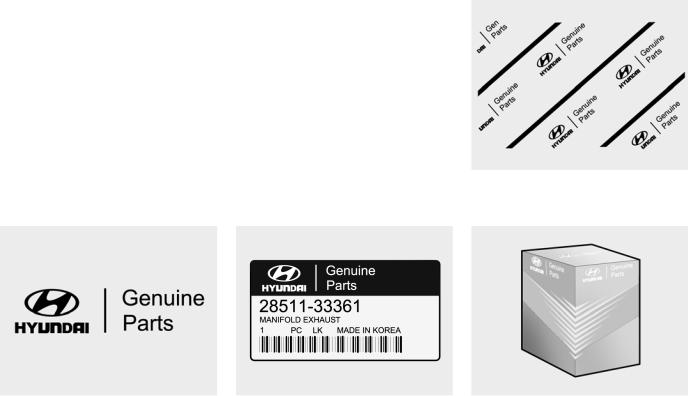
Guide to Hyundai Genuine Parts
1.What are Hyundai Genuine Parts?
Hyundai Genuine Parts are the same parts used by Hyundai Motor Company to manufacture vehicles. They are designed and tested for the optimum safety, performance, and reliability to our customers.
2.Why should you use genuine parts?
Hyundai Genuine Parts are engineered and built to meet rigid manufacturing requirements. Using imitation, counterfeit or used salvage parts is not covered under the Hyundai New Vehicle Limited Warranty or any other Hyundai warranty.
A100A01L
In addition, any damage to or failure of Hyundai Genuine Parts caused by the installation or failure of an imitation, counterfeit or used salvage part is not covered by any Hyundai Warranty.
3.How can you tell if you are purchasing Hyundai Genuine Parts?
Look for the Hyundai Genuine Parts Logo on the package (see below).
Hyundai Genuine Parts exported to are packaged with labels written only in English.
Hyundai Genuine Parts are only sold through authorized Hyundai Dealerships.
A100A02L
A100A03L
A100A04L
F5


|
|
|
|
|
|
|
|
|
Introduction |
|
1 |
|
|
|
|
|
|
|
|
|
Your vehicle at a glance |
|
2 |
|
|
|
|
|
|
|
|
|
Safety system of your vehicle |
|
3 |
|
|
|
|
|
|
|
|
|
Features of your vehicle |
|
4 |
|
|
|
|
|
|
table of contents |
|
|
Driving your vehicle |
|
5 |
|
|
||||
|
|
|
|
|
|
|
|
|
What to do in an emergency |
|
6 |
|
|
|
|
|
|
|
|
|
Maintenance |
|
7 |
|
|
|
|
|
|
|
|
|
Specifications, Consumer information and |
|
8 |
|
|
|
Reporting safety defeccts |
|
|
|
|
|
|
||
|
|
|
|
|
|
|
|
|
Index |
|
I |
|
|
|
|
|
|
|
|
|
|
|
|

Introduction |
|
1 |
|
|
|
How to use this manual / 1-2
Fuel requirements / 1-2
Vehicle handling instructions / 1-4
Vehicle break-in process / 1-5
Vehicle data collection and event data recorders / 1-5
Indicator symbols on the instrument cluster / 1-6
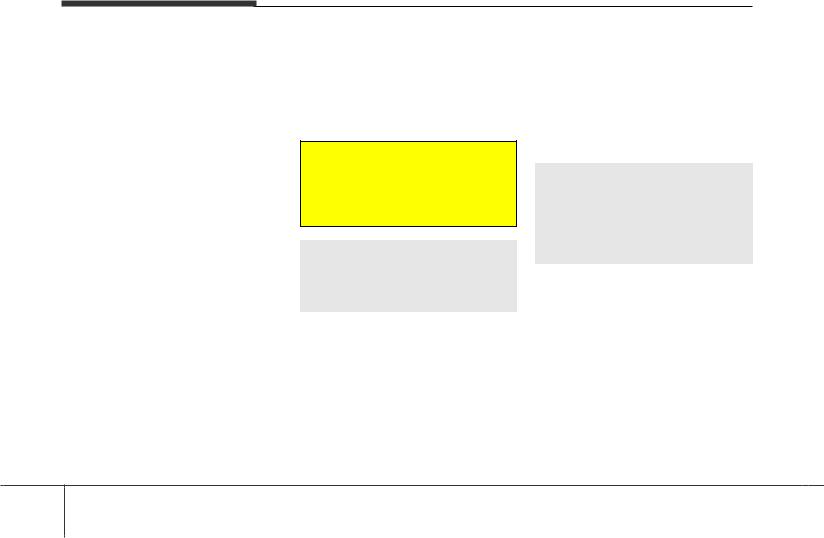
Introduction
HOW TO USE THIS MANUAL
A010000AUN
We want to help you get the greatest possible driving pleasure from your vehicle. Your Owner’s Manual can assist you in many ways. We strongly recommend that you read the entire manual. In order to minimize the chance of death or injury, you must read the WARNING and CAUTION sections in the manual.
Illustrations complement the words in this manual to best explain how to enjoy your vehicle. By reading your manual, you will learn about features, important safety information, and driving tips under various road conditions.
The general layout of the manual is provided in the Table of Contents. A good place to start is the index; it has an alphabetical listing of all information in your manual.
Sections: This manual has eight sections plus an index. Each section begins with a brief list of contents so you can tell at a glance if that section has the information you want.
You’ll find various WARNINGS, CAUTIONS, and NOTICES in this manual. These were prepared to enhance your personal safety.You should carefully read and follow ALL procedures and recommendations provided in these WARNINGS, CAUTIONS and NOTICES.
 WARNING
WARNING
A WARNING indicates a situation in which harm, serious bodily injury or death could result if the warning is ignored.
 CAUTION
CAUTION
A CAUTION indicates a situation in which damage to your vehicle could result if the caution is ignored.
NOTICE
ANOTICE indicates interesting or helpful information is being provided.
FUEL REQUIREMENTS
Your new vehicle is designed to use only unleaded fuel having a pump octane number((RTM)/2) of 87 or higher.
Your new vehicle is designed to obtain maximum performance with UNLEADED FUEL, as well as minimize exhaust emissions and spark plug fouling.
 CAUTION
CAUTION
Never add any fuel system cleaning agents to the fuel tank other than what has been specified. (Consult an authorized HYUNDAI dealer for details.)
1 2
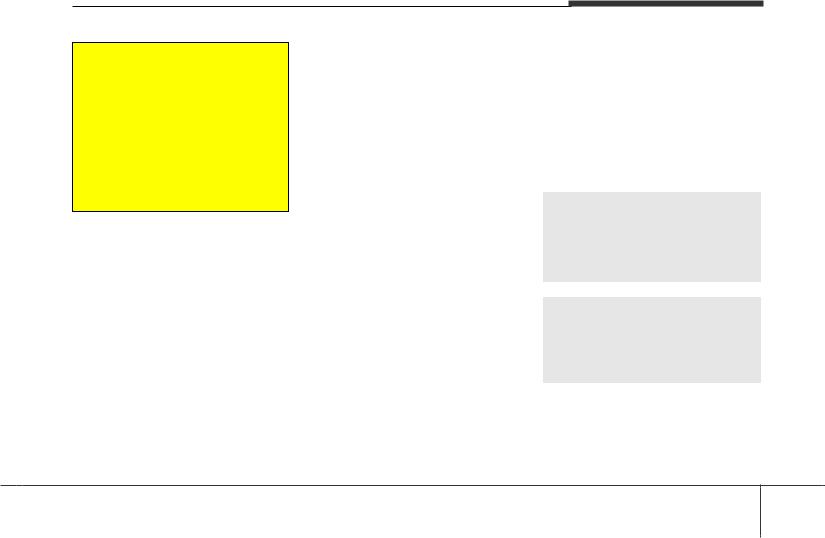
 WARNING
WARNING
•Do not "top off" after the nozzle automatically shuts off when refueling.
•Tighten the cap until it clicks, otherwise the Check Engine  light will illuminate.
light will illuminate.
•Always check that the fuel cap is installed securely to prevent fuel spillage in the event of an accident.
Introduction
A020103AUN
Gasoline containing alcohol and methanol
Gasohol, a mixture of gasoline and ethanol (also known as grain alcohol), and gasoline or gasohol containing methanol (also known as wood alcohol) are being marketed along with or instead of leaded or unleaded gasoline.
Do not use gasohol containing more than 10% ethanol, and do not use gasoline or gasohol containing any methanol. Either of these fuels may cause drivability problems and damage to the fuel system.
Discontinue using gasohol of any kind if drivability problems occur.
Vehicle damage or driveability problems may not be covered by the manufacturer’s warranty if they result from the use of:
1.Gasohol containing more than 10% ethanol.
2.Gasoline or gasohol containing methanol.
3.Leaded fuel or leaded gasohol.
"E85" fuel is an alternative fuel composed of 85 percent ethanol and 15 percent gasoline, and is manufactured exclusively for use in Flexible Fuel Vehicles. “E85” is not compatible with your vehicle. Use of “E85” may result in poor engine performance and damage to your vehicle's engine and fuel system. HYUNDAI recommends that customers do not use fuel with an ethanol content exceeding 10 percent.
 CAUTION
CAUTION
Your New Vehicle Limited Warranty does not cover damage to the fuel system or any performance problems caused by the use of “E85” fuel.
 CAUTION
CAUTION
Never use gasohol which contains methanol. Discontinue use of any gasohol product which impairs drivability.
1 3

Introduction
A020104AUN
Use of MTBE
We recommend that fuels containing MTBE (Methyl Tertiary Butyl Ether) over 15.0% vol. (Oxygen Content 2.7% weight) should not be used in your vehicle.
Fuel containing MTBE over 15.0% vol. (Oxygen Content 2.7% weight) may reduce vehicle performance and produce vapor lock or hard starting.
 CAUTION
CAUTION
Your New Vehicle Limited Warranty may not cover damage to the fuel system and any performance problems that are caused by the use of fuels containing methanol or fuels containing MTBE (Methyl Tertiary Butyl Ether) over 15.0% vol. (Oxygen Content 2.7% weight.)
A020105AUN
Do not use methanol
Fuels containing methanol (wood alcohol) should not be used in your vehicle. This type of fuel can reduce vehicle performance and damage components of the fuel system.
A020106AUN
Gasolines for cleaner air
To help contribute to cleaner air, we recommend that you use gasolines treated with detergent additives, which help prevent deposit formation in the engine. These gasolines will help the engine run cleaner and enhance performance of the Emission Control System.
A020107AUN
Operation in foreign countries
If you are going to drive your vehicle in another country, be sure to:
•Observe all regulations regarding registration and insurance.
•Determine that acceptable fuel is available.
VEHICLE HANDLING
INSTRUCTIONS
As with other vehicles of this type, failure to operate this vehicle correctly may result in loss of control, an accident or vehicle rollover.
Specific design characteristics (higher ground clearance, track, etc.) give this vehicle a higher center of gravity than other types of vehicles. In other words they are not designed for cornering at the same speeds as conventional 2-wheel drive vehicles. Avoid sharp turns or abrupt maneuvers. Again, failure to operate this vehicle correctly may result in loss of control, an accident or vehicle rollover. Be sure to read the “Reducing the risk of a rollover” driving guidelines, in section 5 of this manual.
1 4

VEHICLE BREAK-IN PROCESS
A030000AUN
No special break-in period is needed. By following a few simple precautions for the first 600 miles (1,000 km) you may add to the performance, economy and life of your vehicle.
•Do not race the engine.
•While driving, keep your engine speed (rpm, or revolutions per minute) between 2,000 rpm and 4,000 rpm.
•Do not maintain a single speed for long periods of time, either fast or slow. Varying engine speed is needed to properly break-in the engine.
•Avoid hard stops, except in emergencies, to allow the brakes to seat properly.
•Don't let the engine idle longer than 3 minutes at one time.
•Don't tow a trailer during the first 1,200 miles (2,000 km) of operation.
Introduction
VEHICLE DATA COLLECTION AND EVENT DATA RECORDERS
A040000AFD
This vehicle is equipped with an event data recorder (EDR). The main purpose of an EDR is to record, in certain crash or near crash-like situations, such as an air bag deployment or hitting a road obstacle, data that will assist in understanding how a vehicle's systems performed. The EDR is designed to record data related to vehicle dynamics and safety systems for a short period of time, typically 30 seconds or less. The EDR in this vehicle is designed to record such data as:
*How various systems in your vehicle were operating:
*Whether or not the driver and passenger safety belts were buckled/fastened;
*How far (if at all) the driver was depressing the accelerator and/or brake pedal; and,
*How fast the vehicle was traveling.
These data can help provide a better understanding of the circumstances in which crashes and injuries occur. NOTE: EDR data are recorded by your vehicle only if a nontrivial crash situation occurs; no data are recorded by the EDR under normal driving conditions and no personal data (e.g., name, gender, age, and crash location) are recorded. However, other parties, such as law enforcement, could combine the EDR data with the type of personally identifying data routinely acquired during a crash investigation.
To read data recorded by an EDR, special equipment is required, and access to the vehicle or the EDR is needed.
In addition to the vehicle manufacture, other parties, such as law enforcement, that have the special equipment, can read the information if they have access to the vehicle or the EDR.
1 5
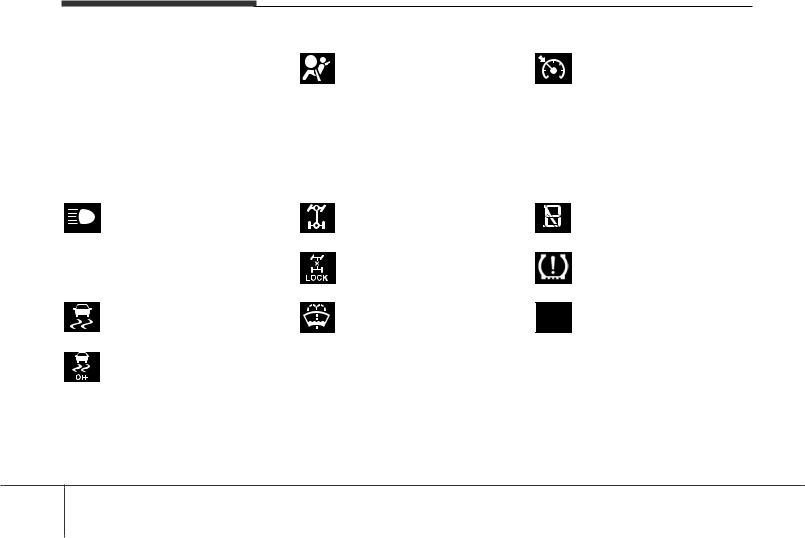
Introduction
INDICATOR SYMBOLS ON THE INSTRUMENT CLUSTER
A050000BFD
Door ajar warning light
Tailgate open warning light
Seat belt warning light
High beam indicator
Turn signal indicator
ESC indicator
ESC OFF indicator
Air bag warning light
Parking brake & Brake fluid warning light
Engine oil pressure warning light
AWD system warning light*
AWD LOCK indicator*
Low windshield washer fluid level warning light*
Charging system warning light
ABS warning light |
|
Malfunction indicator* |
|
|
|
Cruise indicator
Cruise SET indicator
Low fuel level warning light
Shift pattern indicator
Low tire pressure telltale / TPMS(Tire Pressure Monitoring System) malfunction indicator
ECO ECO indicator*
*: if equipped
: For more detailed explanations, refer to section 4, “Instrument cluster”.
1 6

Your vehicle at a glance |
|
2 |
|
|
|
Interior overview / 2-2
Instrument panel overview / 2-3
Engine compartment / 2-4
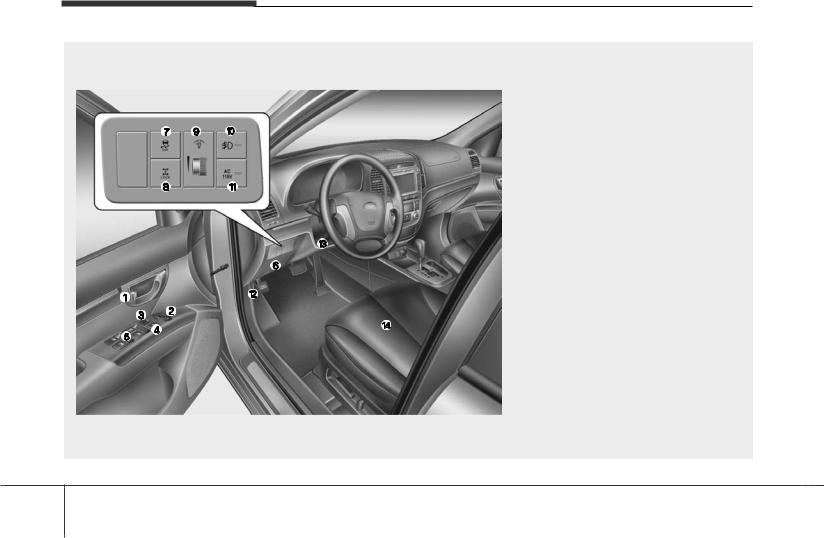
Your vehicle at a glance
INTERIOR OVERVIEW
1. Door lock/unlock button ............................ |
4-8 |
|
2. Outside rearview mirror control switch*..... |
4-38 |
|
3. Central door lock switch* .......................... |
4-8 |
|
4. Power window lock button*..................... |
4-15 |
|
5. Power window switches.......................... |
4-13 |
|
6. Fuse box .................................................. |
7-47 |
|
7. ESC OFF button..................................... |
5-28 |
|
8. AWD Lock button.................................... |
5-17 |
|
9. Instrument panel illumination.................. |
4-41 |
|
10. |
Front fog light button* ........................... |
4-60 |
11. |
AC inverter button* ............................... |
4-93 |
12. |
Hood release lever ............................... |
4-17 |
13. |
Steering wheel tilt ................................. |
4-26 |
14. |
Seat ........................................................ |
3-2 |
* : if equipped
OCM010001N
B010000AFD
2 2
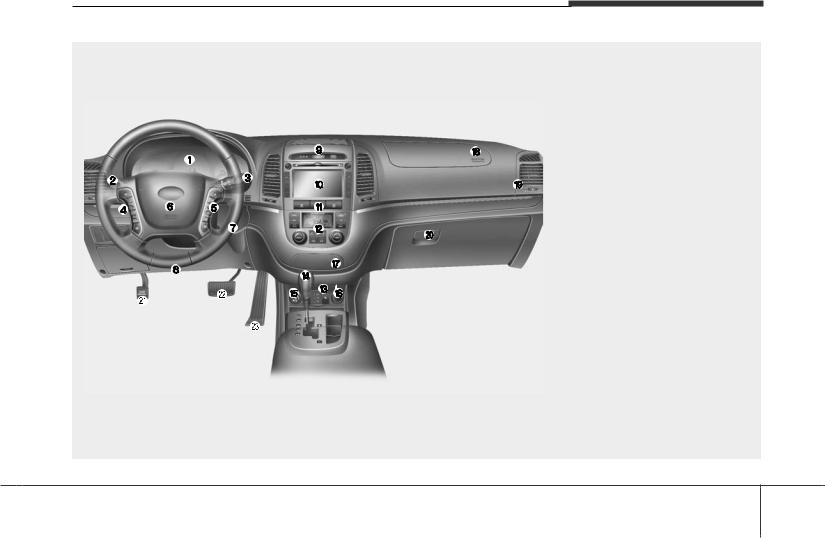
Your vehicle at a glance
INSTRUMENT PANEL OVERVIEW
1. |
Instrument cluster ........................... |
|
4-40 |
|
2. |
Light control / Turn signals .............. |
|
4-57 |
|
3. Wiper/Washer.................................. |
|
4-61 |
||
4. |
Steering wheel audio controls* ....... |
4-99 |
||
5. |
Auto cruise controls* ....................... |
|
5-33 |
|
6. |
Driver’s air bag................................ |
|
3-45 |
|
7. |
Ignition switch ................................... |
|
5-4 |
|
8. |
Steering wheel ................................ |
|
4-26 |
|
9. Digital clock ........................................ |
|
4-94 |
||
10. Audio system*.............................. |
|
4-104 |
||
11. |
Hazard warning flasher switch |
......4-56 |
||
12. Climate control system* ........ |
4-67/4-76 |
|||
13. Seat warmer* ................................ |
|
3-10 |
||
14. |
Shift lever................................ |
|
5-7/5-10 |
|
15. |
Cigarette lighter............................. |
|
4-89 |
|
16. |
Power outlet .................................. |
|
4-92 |
|
17. Ashtray .......................................... |
|
4-89 |
||
18. |
Passenger’s air bag ...................... |
|
3-45 |
|
19. Vent controls ................................. |
|
4-70 |
||
20. Glove box ...................................... |
|
4-86 |
||
21. |
Parking brake pedal ...................... |
|
5-24 |
|
22. Brake pedal................................... |
|
5-23 |
||
23. |
Accelerator pedal ............................ |
|
5-6 |
|
* : if equipped |
|
|
||
OCM010002N
B020000AFD
2 3
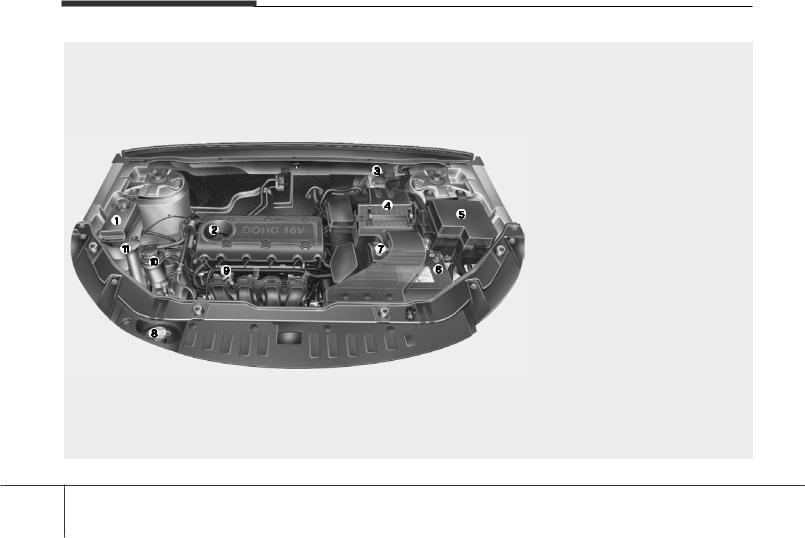
Your vehicle at a glance
ENGINE COMPARTMENT
1. |
Engine coolant reservoir.................. |
7-16 |
2. |
Engine oil filler cap .......................... |
7-14 |
3. |
Brake fluid reservoir......................... |
7-18 |
4. |
Air cleaner ....................................... |
7-22 |
5. Fuse box.......................................... |
7-47 |
|
6. |
Negative battery terminal ................ |
7-29 |
7. |
Positive battery terminal .................. |
7-29 |
8. |
Radiator cap .................................... |
7-17 |
9. |
Engine oil dipstick............................ |
7-14 |
10. Power steering fluid reservoir ........ |
7-19 |
|
11. Windshield washer fluid reservoir.. |
7-20 |
|
* The actual engine room in the vehicle may differ from the illustration.
OXM079001
2 4

Seat / 3-2
Seat belts / 3-17
Child restraint system / 3-28
Airbag-supplemental restraint system / 3-36
Safety system of your vehicle |
|
3 |
|
|
|
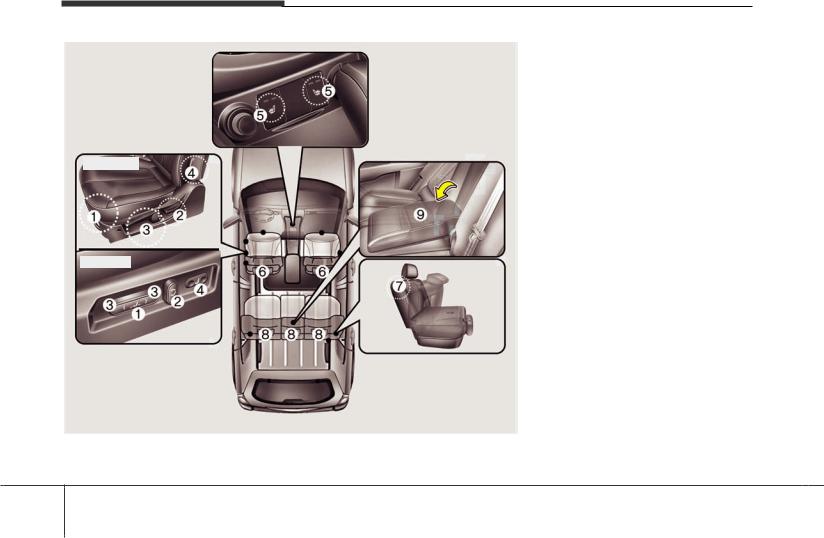
Safety system of your vehicle
SEAT
Manual seat
Power seat
C010000AFD
Front seat
(1)Forward and backward
(2)Seatback angle
(3)Seat cushion height (Driver’s seat)
(4)Lumbar support (Driver’s seat)*
(5)Seat warmer*
(6)Headrest
Rear seat
(7)Seatback angle and folding
(8)Headrest
(9)Armrest
* if equipped
OCM030001N
3 2
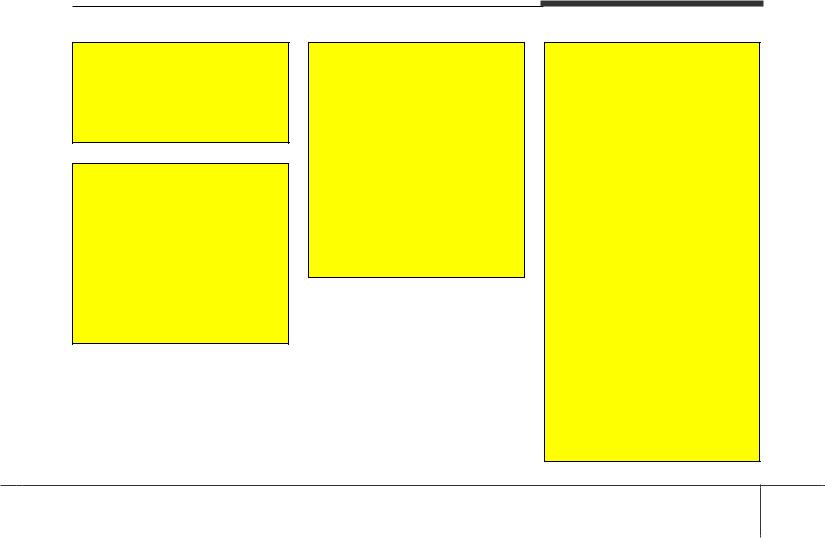
 WARNING - Loose objects
WARNING - Loose objects
Loose objects in the driver’s foot area could interfere with the operation of the foot pedals, possibly causing an accident. Do not place anything under the front seats.
 WARNING - Uprighting seat
WARNING - Uprighting seat
When you return the seatback to its upright position, hold the seatback and return it slowly and be sure there are no other occupants around the seat. If the seatback is returned without being held and controlled, the back of the seat could spring forward resulting in accidental injury to a person struck by the seatback.
 WARNING - Driver responsibility for front seat passenger
WARNING - Driver responsibility for front seat passenger
Riding in a vehicle with a front seatback reclined could lead to serious or fatal injury in an accident. If a front seat is reclined during an accident, the occupant’s hips may slide under the lap portion of the seat belt applying great force to the unprotected abdomen. Serious or fatal internal injuries could result. The driver must advise the front passenger to keep the seatback in an upright position whenever the vehicle is in motion.
Safety system of your vehicle
 WARNING - Driver’s seat
WARNING - Driver’s seat
•Never attempt to adjust seat while the vehicle is moving. This could result in loss of control, and an accident causing death, serious injury, or property damage.
•Do not allow anything to interfere with the normal position of the seatback. Storing items against a seatback or in any other way interfering with proper locking of a seatback could result in serious or fatal injury in a sudden stop or collision.
•Always drive and ride with your seatback upright and the lap portion of the seat belt snug and low across the hips. This is the best position to protect you in case of an accident.
•In order to avoid unnecessary and perhaps severe air bag injuries, always sit as far back as possible from the steering wheel while maintaining comfortable control of the vehicle. It is recommended that your chest is at least 10 inches (250 mm) away from the steering wheel.
3 3
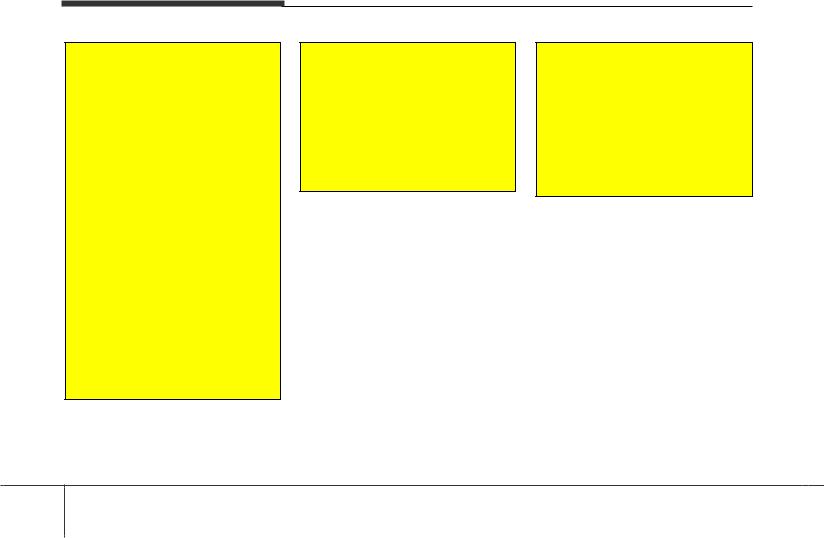
Safety system of your vehicle
 WARNING - Rear seatbacks
WARNING - Rear seatbacks
•The rear seatback must be securely latched. If not, passengers and objects could be thrown forward resulting in serious injury or death in the event of a sudden stop or collision.
•Luggage and other cargo should be laid flat in the cargo area. If objects are large, heavy, or must be piled, they must be secured. Under no circumstances should cargo be piled higher than the seatbacks. Failure to follow these warnings could result in serious injury or death in the event of a sudden stop, collision or rollover.
•No passenger should ride in the cargo area or sit or lie on folded seatbacks while the vehicle is moving. All passengers must be properly seated in seats and restrained properly while riding.
(Continued)
(Continued)
•When resetting the seatback to the upright position, make sure it is securely latched by pushing it forward and backwards.
•To avoid the possibility of burns, do not remove the carpet in the cargo area. Emission control devices beneath this floor generate high temperatures.
 WARNING
WARNING
After adjusting the seat, always check that it is securely locked into place by attempting to move the seat forward or reverse without using the lock release lever. Sudden or unexpected movement of the driver's seat could cause you to lose control of the vehicle resulting in an accident.
3 4
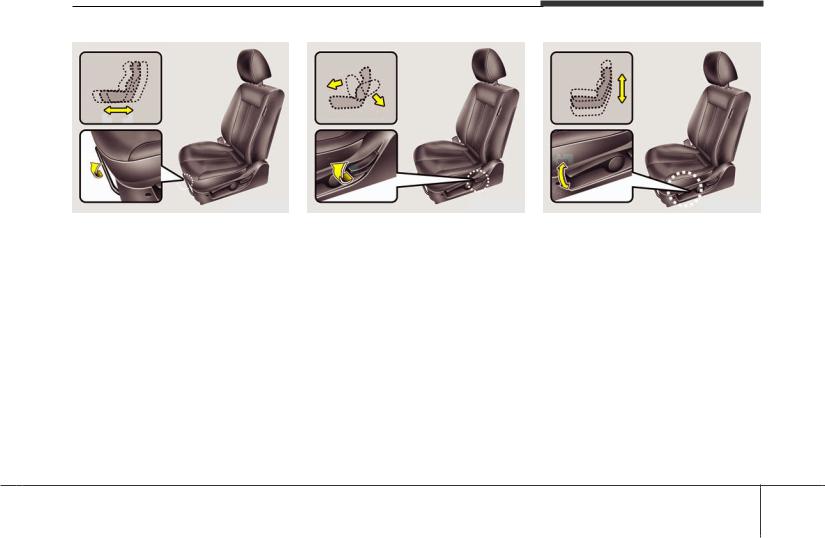
Safety system of your vehicle
OCM030002
Front seat adjustment - Manual
C010101AUN
Forward and backward
To move the seat forward or backward:
1.Pull the seat slide adjustment lever under the front edge of the seat cushion up and hold it.
2.Slide the seat to the position you desire.
3.Release the lever and make sure the seat is locked in place.
Adjust the seat before driving, and make sure the seat is locked securely by trying to move forward and backward without using the lever. If the seat moves, it is not locked properly.
OCM030003
C010102AUN
Seatback angle
To recline the seatback:
1.Lean forward slightly and lift up on the seatback recline lever located on the outside of the seat at the rear.
2.Carefully lean back on the seat and adjust the seatback of the seat to the position you desire.
3.Release the lever and make sure the seatback is locked in place. (The lever MUST return to its original position for the seatback to lock.)
OCM030004
C010103AUN
Seat cushion height (for driver’s seat)
To change the height of the seat cushion, push the lever that is located on the outside of the seat cushion upwards or downwards.
•To lower the seat cushion, push down the lever several times.
•To raise the seat cushion, pull up the lever several times.
3 5
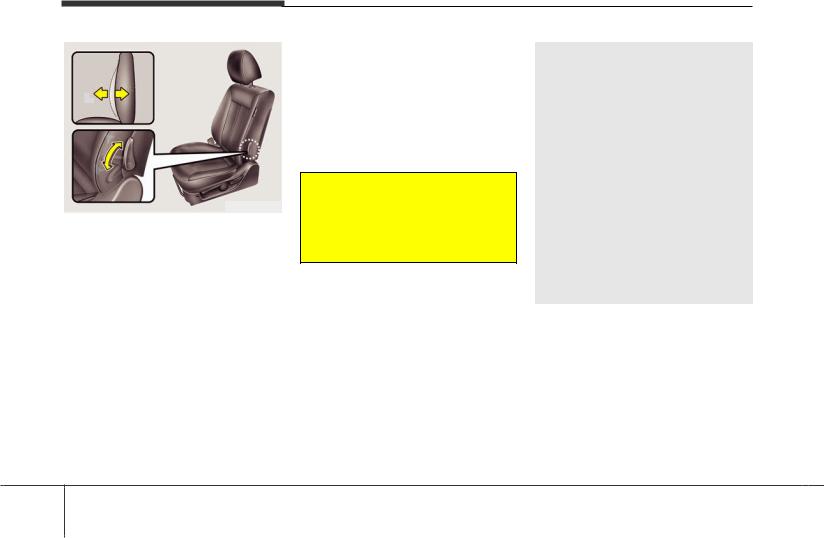
Safety system of your vehicle
OCM030005
C010105AFD
Lumbar support
(for driver’s seat, if equipped)
The lumbar support can be adjusted by moving the lever on the outside of the driver’s seatback. Pivoting the lever increases or decreases lumbar support.
Front seat adjustment - power (if equipped)
The front seat can be adjusted by using the control switches located on the outside of the seat cushion. Before driving, adjust the seat to the proper position so as to easily control the steering wheel, pedals and switches on the instrument panel.
 WARNING
WARNING
The power seat is operable with the ignition OFF.
Therefore, children should never be left unattended in the vehicle.
 CAUTION
CAUTION
•The power seat is driven by an electric motor. Stop operating once the adjustment is completed. Excessive operation may damage the electrical equipment.
•When in operation, the power seat consumes a large amount of electrical power. To prevent unnecessary charging system drain, don’t adjust the power seat longer than necessary while the engine is not running.
•Do not operate two or more power seat control switches at the same time. Doing so may result in power seat motor or electrical component malfunction.
3 6

Safety system of your vehicle
OCM030006
Forward and backward
Push the control switch forward or backward to move the seat to the desired position. Release the switch once the seat reaches the desired position.
OCM030007
Seatback angle
Push the control switch forward or backward to move the seatback to the desired angle. Release the switch once the seat reaches the desired position.
OCM030008
Seat height (for driver’s seat)
Pull the front portion of the control switch up to raise or down to lower the front part of the seat cushion. Pull the rear portion of the control switch up to raise or down to lower the rear part of the seat cushion. Release the switch once the seat reaches the desired position.
3 7
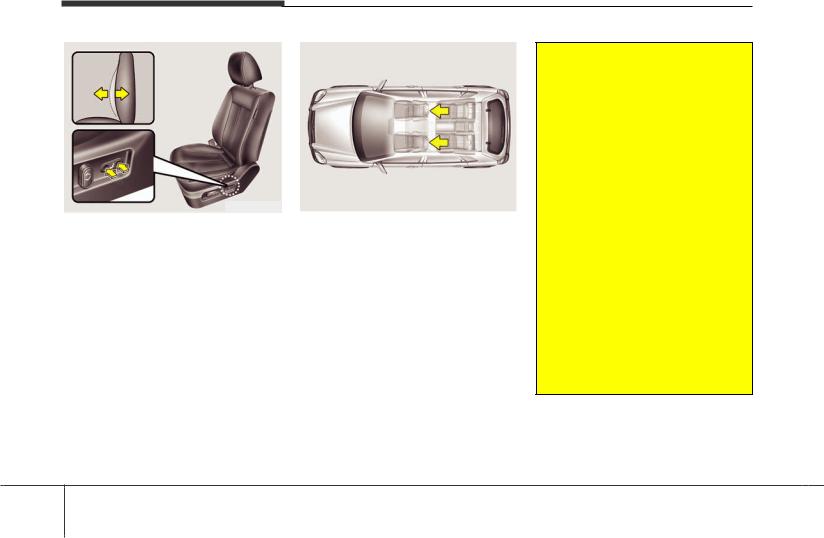
Safety system of your vehicle
OCM030009
Lumbar support (for driver’s seat)
The lumbar support can be adjusted by pressing the button.
OJM069015
C010104BFD
Headrest
The driver's and front passenger's seats are equipped with a headrest for the occupant's safety and comfort.
The headrest not only provides comfort for the driver and front passenger, but also helps to protect the head and neck in the event of a collision.
 WARNING
WARNING
•For maximum effectiveness in case of an accident, the headrest should be adjusted so the middle of the headrest is at the same height of the center of gravity of an occupant's head. Generally, the center of gravity of most people's head is similar with the height of the top of their eyes. Also, adjust the headrest as close to your head as possible. For this reason, the use of a cushion that holds the body away from the seatback is not recommended.
•Do not operate the vehicle with the headrests removed as severe injury to the occupants may occur in the event of an accident. Headrests may provide protection against neck injuries when properly adjusted.
•Do not adjust the headrest position of the driver's seat while the vehicle is in motion.
3 8
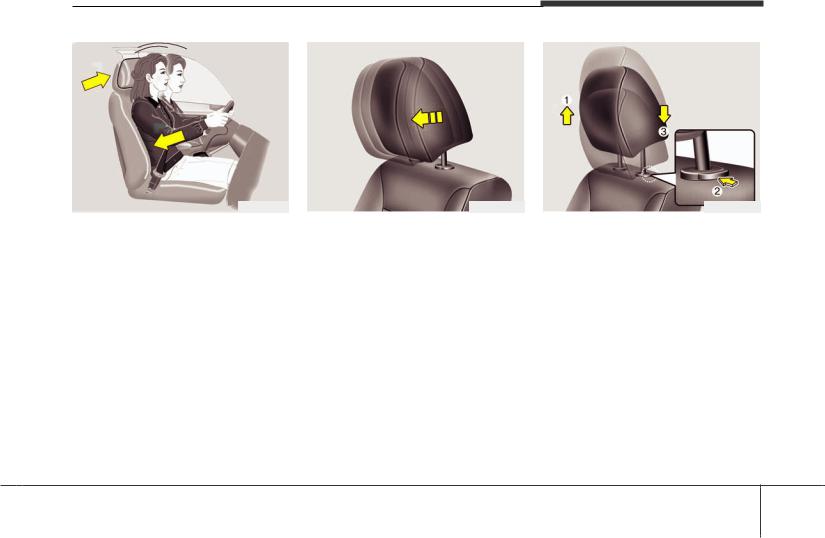
Safety system of your vehicle
HNF2041-1
Active headrest (if equipped)
The active headrest is designed to move forward and upward during a rear impact. This helps prevent the driver's and front passenger’s heads from moving backward and thus helps minimize neck injuries.
For your safety, the active headrest can’t be removed. If there is any problem with the active headrest, take your vehicle to an authorized HYUNDAI dealer and have the system checked.
OCM030010
Forward and backward adjustment (if equipped)
The headrest may be adjusted forward to 3 different positions by pulling the headrest forward to the desired detent. To adjust the headrest to it’s furthest backwards position, pull it fully forward to the farthest position and release it. Adjust the headrest so that it properly supports the head and neck.
OCM030011
Adjusting the height up and down
To raise the headrest, pull it up to the desired position (1). To lower the headrest, push and hold the release button (2) on the headrest support and lower the headrest to the desired position (3).
3 9
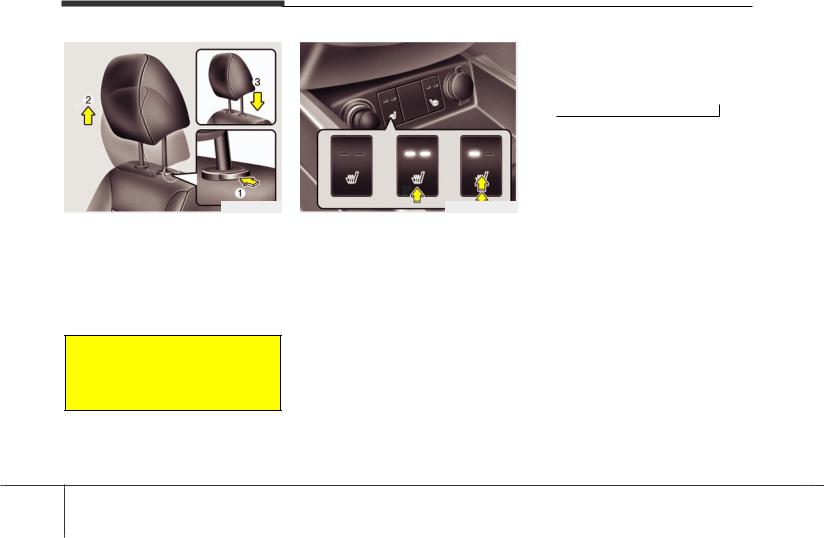
Safety system of your vehicle
OCM030012
Removal
To remove the headrest, raise it as far as it can go then press the release button (1) while pulling upward (2).
To reinstall the headrest, put the headrest poles (3) into the holes while pressing the release button (1). Then adjust it to the appropriate height.
 WARNING
WARNING
Make sure the headrest locks in position after adjusting it to properly protect the occupants.
OCM029145N-2
C010107AFD
Seat warmer (if equipped)
The seat warmer is provided to warm the front seats during cold weather. With the ignition switch in the ON position, push either of the switches to warm the driver's seat or the front passenger's seat.
During mild weather or under conditions where the operation of the seat warmer is not needed, keep the switches in the "OFF" position.
•Each time you push the button, the temperature setting of the seat is changed as follows :
OFF → HIGH (
 ) → LOW (
) → LOW ( )
)
→
•The seat warmer defaults to the OFF position whenever the ignition switch is turned on.

 : HIGH
: HIGH  : LOW
: LOW
3 10
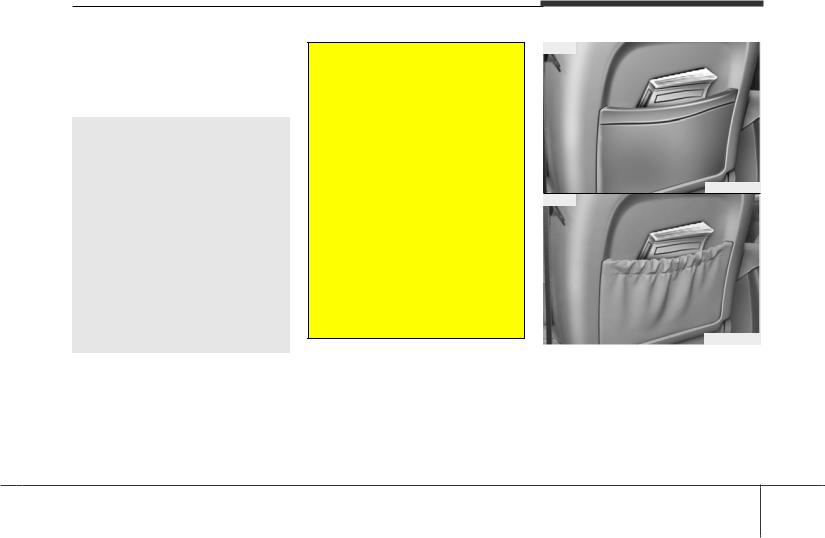
NOTICE
With the seat warmer switch in ON position, the heating system in the seat turns off or on automatically depending on the seat temperature.
 CAUTION
CAUTION
•When cleaning the seats, do not use an organic solvent such as thinner, benzene, alcohol and gasoline. Doing so may damage the surface of the heater or seats.
•To prevent overheating the seat warmer, do not place blankets, cushions or seat covers on the seats while the seat warmer is in operation.
•Do not place heavy or sharp objects on seats equipped with seat warmers. Damage to the seat warming components could occur.
 WARNING - Seat warmer burns
WARNING - Seat warmer burns
Passengers should use extreme caution when using seat warmers due to the possibility of excess heating or burns. In particular, the driver must exercise extreme care for the following types of passengers:
1.Infants, children, elderly or handicapped persons, or hospital outpatients
2.Persons with sensitive skin or those that burn easily
3.Fatigued individuals
4.Intoxicated individuals
5.Individuals taking medication that can cause drowsiness or sleepiness (sleeping pills, cold tablets, etc.)
Safety system of your vehicle
Type A
OMG039017
Type B
OHM038010
C010108AUN
Seatback pocket (if equipped)
The seatback pocket is provided on the back of the front passenger’s and driver’s seatbacks.
3 11
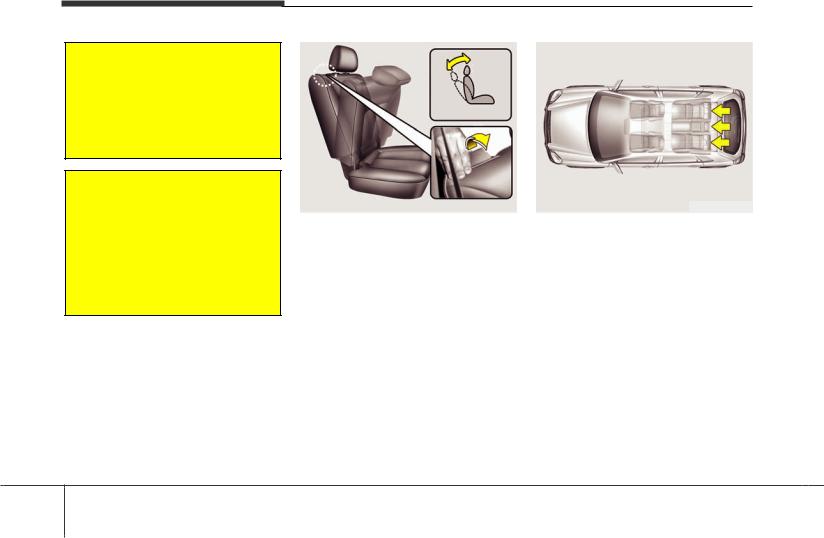
Safety system of your vehicle
 WARNING - Seatback pockets
WARNING - Seatback pockets
Do not put heavy or sharp objects in the seatback pockets. In an accident they could come loose from the pocket and injure vehicle occupants.
 WARNING
WARNING
For proper operation of the occupant classification system:
•Do not place any items cumulatively weighing over 2.2 lbs (1 kg) in the seatback pocket or on the seat.
•Do not hang onto the front passenger seat.
OCM030062N
Rear seat adjustment
Seatback angle
To recline the seatback:
1.Pull up the seatback recline lever.
2.Hold the lever and adjust the seatback of the seat to the position you desire.
3.Release the lever and make sure the seatback is locked in place. (The lever MUST return to its original position for the seatback to lock.)
OJM069015R
Headrest
The rear seat(s) is equipped with headrests in all the seating positions for the occupant's safety and comfort.
The headrest not only provides comfort for passengers, but also helps protect the head and neck in the event of a collision.
3 12
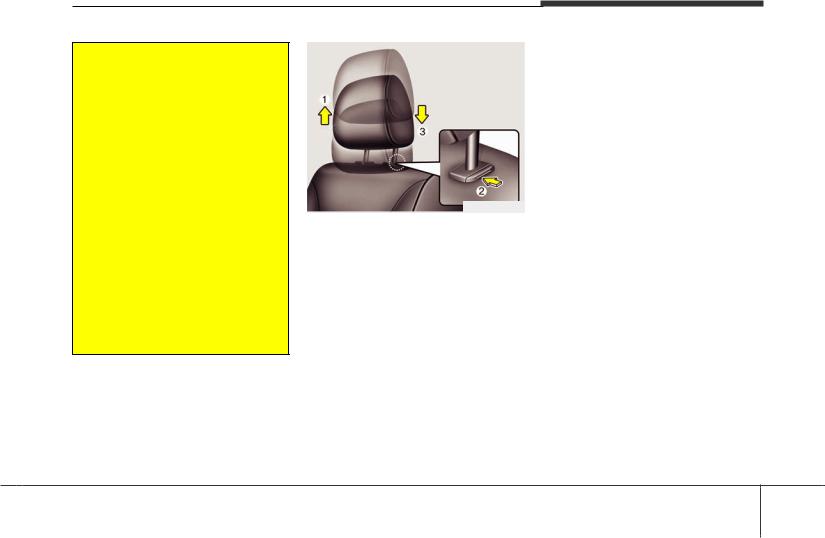
Safety system of your vehicle
 WARNING
WARNING
•For maximum effectiveness in case of an accident, the headrest should be adjusted so the middle of the headrest is at the same height of the center of gravity of an occupant's head. Generally, the center of gravity of most people's head is similar with the height of the top of their eyes. Also adjust the headrest as close to your head as possible. For this reason, the use of a cushion that holds the body away from the seatback is not recommended.
•Do not operate the vehicle with the headrests removed. Severe injury to an occupant may occur in the event of an accident. Headrests may provide protection against severe neck injuries when properly adjusted.
OCM030060N
Adjusting the height up and down
To raise the headrest, pull it up to the desired position (1). To lower the headrest, push and hold the release button (2) on the headrest support and lower the headrest to the desired position (3).
Removal
The headrest can’t be removed. If there is any problem with the headrest, take your vehicle to an authorized HYUNDAI dealer and have the system checked.
3 13
